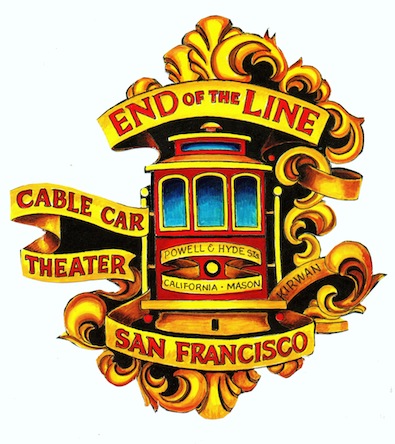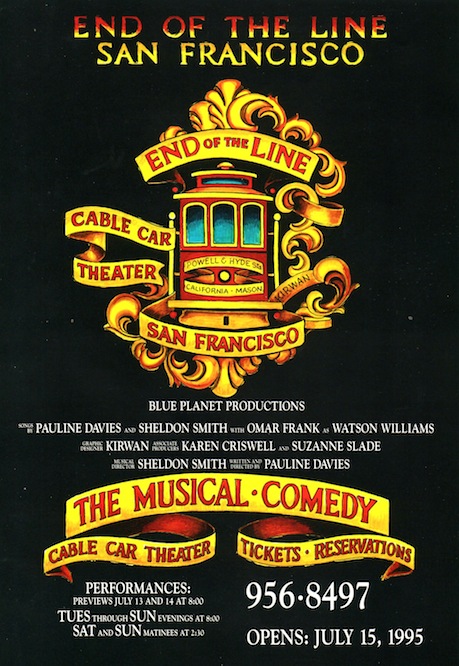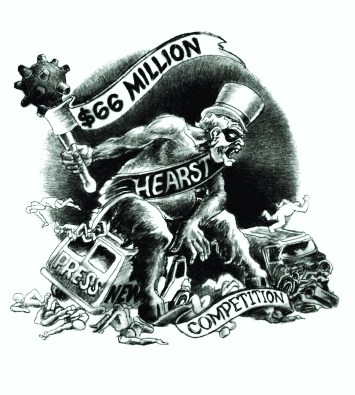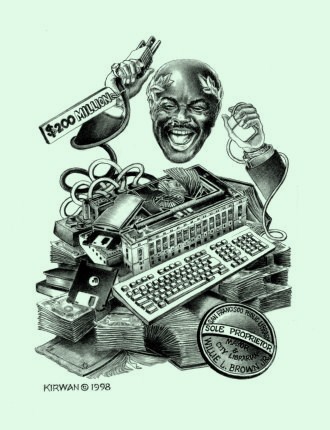![]()
.
End Of The Line By Jim Kirwan
|
|
In July of 1996 I was involved in the production of a Musical Comedy, in San Francisco: At of all places, The Cable Car Theater in the Theater District of the city. This morning I decided to take a walk through the city along the same cable car tracks that have been there seemingly forever—just to see how this world has changed in the intervening nineteen years. Back then our ticket-holders came from a combination of tourists and the local people. So I drew a map, to advertise the show and since the cable-cars never bothered making one, it worked for us as well. The hotels, restaurants, clubs, bars and coffee shops loved them because people always wondered where the cable cars were and where they went. And of course it didn’t hurt when they turned up at the Cable-Car Theater either. This morning I began down at Fisherman’s Warf, one of the many spots where most tourists seem to find their way to, as part of the city. Then they were still a functioning mini-port that sold their daily catch to local fish mongers and restaurants, as well as through local cafes and street vendors, as part of the ambiance. This morning Fisherman’s Warf was but a very dim shadow of itself. For the last several years the boats have needed to keep going farther and farther out to catch supposedly safe fish because the bay is filthy and in many places toxic. That toxicity was left over from the days of the Motherload and the gold-miners that blasted their way into history and left San Francisco Bay with their toxic residue. But this morning had much more to do with the total absence of any sardines, anywhere on the Pacific Coast, and the concomitant die off’s of other eatable life from the Pacific Ocean. Never the less there are still no warning signs and there are still plenty of fish sold in the stores and restaurants of the city. Apparently San Franciscans never knew how to use a Geiger counter. The herds of tourists have been shrinking anyway, but the Warf is not a place with any soul at all any longer—it’s just a tourist trap now, since Diane Feinstein got rid of the working parts of the Port of San Francisco. A few blocks from the Warf you can catch the Hyde Street Cable Car that makes the long steep climb up from the Warf and into Embassy Row atop the public overlook for the bay. The embassies are sumptuous but much smaller than they are in most other cities: Despite the fact that San Francisco is one of the most expensive cities in the United States, or the world, to try to live in. Russian Hill is next, where condos and apartments abound. Most of these are immaculately kept and they are needless to say “private”. Next Hyde Street then begins a tortured climb that takes you to Nob Hill that was once the home to many of the magnates who made both the West and San Francisco famous. But the differences between the huge buildings that were built to accommodate the wealthy have been converted and most of the people on Nob Hill today are not rich, but are mainly just working people: Composed of virtually every kind of background and ethnicity. However where the new techies have decided to stake out some neighborhoods, the rents can run from $4,000 to $8,000 for an apartment. If you have a car it will cost you more to park it for the month than most of those on rent-control pay for their much smaller apartments. But the views are breathtaking. As you cross California Street the evidence of our real changes are much more apparent. The luxury aspect has been somewhat tarnished, and the neighborhood storefronts are pockmarked with continuing changes that happen monthly now. Graffiti has begun to fill in the blanks both on the streets and on the windows of a few of the businesses. Traffic get’s much angrier after crossing California, because all that’s left for drivers, is to get through what’s coming up, and on to wherever they really want to be: Because there are no longer many “destinations” between California and City Hall, or Market Street. As I walked I could not help noticing the sidewalks gradually becoming choked with trash, graffiti, and waste of all kinds from those with two legs as well as four. The air was foul, and the sewers are in need of being pumped-out, something the city no longer bothers with where the ‘bums’ live: Because they don’t actually count for much, anywhere in San Francisco. The city spends billions on making the sidewalks and the streets safe in the right districts, but the poor get nothing, in fact they’re getting less and less as the number of those living on the streets continues to grow. The city has programs to disappear the homeless, systematically now. Just in case you might have once gotten to know some of them, or found a way to care about them at all. After a few more blocks you will begin to see more squad cars from both the city and the Department of HOMELAND Insecurity, prowling through the neighborhoods where the nice people never go. By the time you approach the Tenderloin, which was once the red-light-district; the streets are being cleaned by corporate-slaves in uniforms that scream “PRIVATE” at anyone that happens to notice. But the effect of cleanliness is brief and quickly reverts back to the way it was before the sidewalks got power-washed, and the trash cans get picked up.
None of this really matters because no one wants to live in the Tenderloin, or as we call it “the Knees of Nob Hill”. The people who do live there are of two types. There are invisible families mostly from the Far East and they are not very visible. Then there are the blacks and some Mexicans, along with ex-cons, thugs, gang-bangers, the unemployed and the unsuccessful of all races and on and on we go back into the underbelly a major city. Ironically just a few blocks to the East is the once thriving Financial District, which gives way to the old Theater District that used to be bordered by art galleries and boutiques, along with major department stores: That’s mostly all gone now. Real life was replaced by Starbuck’s, sometimes three to a block interspersed check-cashing stores and with long-shot business efforts that always begin underfunded and seldom last more than two months, because down there there is no longer any business, and damn little “survival” going on for anyone unlucky enough to be there. It feels more like Bombay or Calcutta than the USA. That’s the general lay of the land in the heart of this city: A city that once actually had a way of life that’s been tortured out of existence, while the survivors are routinely murdered by either the economy, Zero Tolerance or Political Correctness. Someone ought to hold a ceremonial burial for the City of San Francisco because it died just about the time that Junior stole the nation and began to make war upon the world.
But there’s another landscape here that you might miss if you’re not careful. It’s the social-map of what now passes for the city that actually dictates what San Francisco has become as well as what it cannot ever return to being. Once upon a time San Francisco actually had newspapers and industry and publications that interacted with the world at large. It was an exciting place to live and work: Today there’s nothing here but trash in all its forms, beginning with the human waste that refers to itself as the tech-crowd who have come to put the walking dead in our proper places, which is, far, far away from here—or at least it will be once they finish pricing us out of a place to live and socially forbidding everything else that was once considered normal. When Downtown Willie-Brown took over he rang the death-knell for everything that had a following. He began his thunderous-thefts by stealing the Public-Library and giving it to private corporations and the phone company among other creatures, and everything went straight downhill from there. Willie managed to evict 70% of the black population and all of the Jazz Scene while he was running the Assembly from Sacramento, in his 28 year long preparation for his role as “public-executioner” for the City of San Francisco: And everything that once made living here a little bit of heaven, while it lasted.
Restaurants, clubs, coffee houses and entertainment functioned around the clock. The stores held a virtual treasure trove from the high end all the way down to the antique shops and second-hand stores that prided themselves on the variety of what was offered. Now the city rolls up its sidewalks by 9 at night because there’s no business anywhere here. Unless you count the occasional late night football game that keeps the drunks howling until after two, but that’s not business it’s just noise. This is what the bulk of the bodies wandering around the city believe in. It’s how they live and breathe every day and every night. They’re dead already and genuinely have absolutely no idea at all about any of this. When the slaughter happens these creatures will just be road-kill, nothing more: http://www.youtube.com/watch?v=OINa46HeWg8 And as for the rest of us in this forgotten hell: Here’s what’s about to happen to us and to the road-kill that still has no idea about anything in any aspect of life today. Try and imagine how they’ll fare in this coming slaughter of everything that too many thought they could actually keep look carefully in the video, can you see anyone being able to survive in this? “The Late Great United States” http://www.youtube.com/watch?v=HqYOkNxQZCs 3min 21seconds on the future
I sincerely doubt that, which is why this might well be The END of the LINE For a lot more than just the people of San Francisco.
|
| Donate to Rense.com Support Free And Honest Journalism At Rense.com | Subscribe To RenseRadio! Enormous Online Archives, MP3s, Streaming Audio Files, Highest Quality Live Programs |
<



 This
city was a 24 hour city, before Willie and his “Political Correctness”
crowd came to power.
This
city was a 24 hour city, before Willie and his “Political Correctness”
crowd came to power.